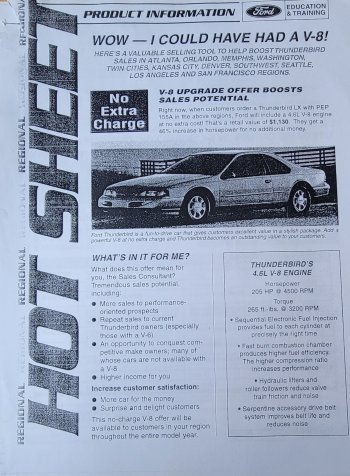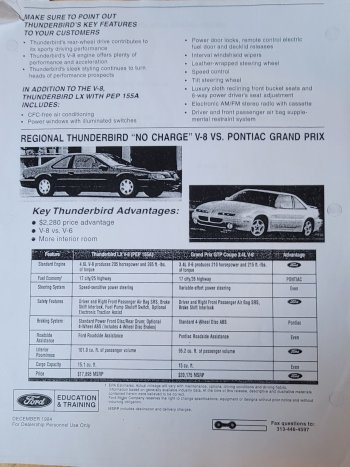Someone messed up the number for 97s, it's over 85,000.
1989
3.8L T-Bird: 102,059
3.8L SC: 12,809
3.8L SC 5-speed manuals: 8,041
3.8L Cougar LS: 92,466
3.8L XR7: 4,780
3.8L XR7 5-speed manuals: 2,101
Total 1989 T-birds: 122,909
Total 1989 Cougars: 97,246
Total 1989: 220,155
1990
3.8L T-Bird: 82,636
3.8L SC: 21,966
3.8L SC 5-speed manuals: 6,067
35th Anniversary edition: 3,371
3.8L Cougar LS: 77,084
3.8L XR7: 4,156
3.8L XR7 5-speed manuals: 823
Total 1990 T-birds: 114,040
Total 1990 Cougars: 81,240
Total 1990: 195,280
1991
5.0L T-Bird: 16,232
3.8L T-Bird: 59,543
3.8L SC: 7,039
3.8L SC 5-speed manuals: 1,905
3.8L Cougar: 53,676
5.0L Cougar: 10,146
Total 1991 Cougars: 63,822
Total 1991 T-birds: 84,719
Total 1991: 148,541
1992
5.0L T-Bird: 12,562
3.8L T-Bird: 57,119
3.8L SC: 4,212
3.8L SC 5-speed manuals: 1,256
LS/XR7 Cougars: 42,182
25th Anniversary Edition Cougars: 4,800
Total 1992 Cougars: 46,982
Total 1992 T-birds: 75,149
Total 1992: 122,131
1993
5.0L T-Bird: 19,587
3.8L T-Bird: 106,234
3.8L SC: 3,891
3.8L SC 5-speed manuals: 1,038
Total 1993 Cougars: 79,700
Total 1993 T-bids: 130,750
Total 1993: 210,450
1994
4.6L T-Bird: 66,657
3.8L T-Bird: 51,056
3.8L SC: 2,647
3.8L SC 5-speed: 722
Total 1994 Cougars: 71,026
Total 1994 T-birds: 121,082
Total 1994: 192,108
1995
4.6L T-Bird: 94,155
3.8L T-Bird: 14,927
3.8L SC: 5,741
3.8L SC 5-speed: 574
Total 1995 Cougars: 60,201
Total 1995 T-birds: 115,397
Total 1995: 175,598
1996
4.6L T-Bird: 86,522
3.8L T-Bird: 25,780
Total 1996 Cougars: 38,929
Total 1996 T-birds: 112,302
Total 1996: 151,231
1997
4.6L T-Bird: 66,320
3.8L T-Bird: 18,956
XR7 Cougars: 27,454
30th Anniversary Cougars: 7,813
Total 1997 Cougars: 35,267
Total 1997 T-birds: 85,276
Total 1997: 120,543



